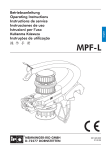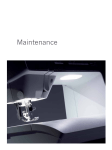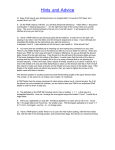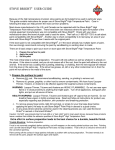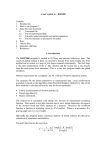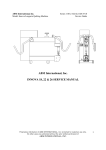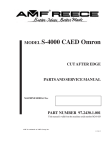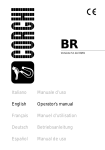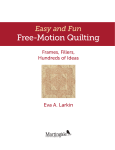Download Thread
Transcript
The Long and Short of Needles and Threads Jane Clark Monarch Quilts LLC Brighton, MI www.monarchquilts.com [email protected] Needles and Threads • Items Affecting Stitch Quality – Needles – Thread size and fiber type – Thread spools/cones and storage – Threading your machine – Proper tension – Bobbin tension – Quality of thread – Your quilt sandwich Items Affecting Stitch Quality • Needles and threads go hand in hand – In a sense, they are “married” together. – There can be many reasons why the results you get in their use are not as good as expected – Some of those causes are why we are here talking about it today. Needles • Knowing the parts of a needle Needles • Is it a “new” or “newer” needle?Have you sewn over bulky heavy seams? • Is the size of the needle correct for the type of thread you are using? • Generally speaking, a 4.0 is optimal (and recommended) for Gammills – 5.0 (and largest) = size 100 Use for heaviest of fabrics – 4.0 = size 18 Use for most all fabrics – 3.5 = size 16 Use with finer threads and finer fabrics – 3.0 = size 14 Use with the finest of threads and finest of fabrics. • How long does a needle last? • How many quilts can I quilt with 1 needle? Industrial Use Needles • System numbers are important in selecting the correct industrial needle type. • For example, “134/R” is a system number for industrial sewing machines and what Gammill uses. Many other brands also use this system number • Groz Beckert, Organ and Schmetz are examples of manufacturers of industrial needles. Industrial Use Needles System Numbers Needle Size Industrial Use Needles System Numbers Needle Size Domestic Use Needles • For domestic sewing machines, Klasse, Schmetz, Organ, etc. would all be brand names you would look for along with the needle size. • Typically you would only be interested in the needle size when looking for an appropriate needle as all domestic machines work with the same system number. Domestic Use Needles Brand Name Needle Size Thread Size and Fiber Type Many different manufacturers A&E Yli Superior Aurofil Sulky •Thread “fibers” or “staples” •“Economical” threads will have “fuzz” or “slubs” on the spool. •This could affect both the machines tension and yours. Thread Size and Fiber Type Fuzzy Thread “Slub” Better Thread, Very little “Slubs” Thread Size and Fiber Type • A cone of thread is the most widely used. • You can use small spools by changing the threading and using the optional horizontal spool holder on the Gammill. • Store threads out of direct sunlight, sunlight causes them to rot. • Spools/cones of threads should be kept as dust free as possible. Thread Size and Fiber • TEX is a weight of thread in grams used by industrial manufacturers. • A #/ply is how many strands are spun. • The smaller the number, the finer the thread. • The larger the number, the heavier the thread. • Cotton is a natural fiber for thread and breaks easier than Polyester. • Polyester thread can be run faster on the Gammill with less breakage. Thread Size and Fiber Type Fibers used to make industrial sewing threads come from two major sources: • Natural Fibers – Come from plant or animals, such as cotton, rayon, wool, jute, silk, hemp, etc. • Synthetic Fibers – Are made from various chemicals that are then melt-spun or wet-spun into a continuous filament fibers such as polyester and nylon. Thread Manufacturing Types Spun threads are made from staple fibers that are spun into single yarns and then two or more of these yarns are plied to make a sewing thread. Thread Manufacturing Techniques Textured threads (not used for Quilting)are made from continuous filaments of polyester or nylon that have been textured and then heat set to insure proper bulk-retention. Examples are “Wooly Nylon” by YLI or “Poly Yarn” by Superior Thread Manufacturing Techniques Monofilament threads are made from single continuous filaments of nylon that resemble fishing line. Monofilament threads are translucent and blend in with many colors. They can be run with another color if desired Thread Manufacturing Techniques Core threads are made by spinning a staple wrapper of cotton or polyester around a continuous filament of polyester fibers. Afterwards, two or more of these single yarns are twisted together to form the thread. Bobbin Case Bobbin Spring: Does it need to be replaced? How do you know it needs to be replaced? Which bobbin spring should you use? Type A or Type B? Do I even need a bobbin spring? Type A Type B Winding A Bobbin • Winding A Bobbin • Gammill Stand Alone Bobbin Winder – Keep it lubricated/oiled – Winding speed should be a consistent rate of speed, not too fast or slow, but one rate of speed. – Pre wound bobbins can be used also Tension, Tension, Tension!! • Is it YOUR tension or is it the BOBBIN’S tension? • Begin by checking YOUR BOBBIN TENSION FIRST!!!! • Check it with a full, properly wound bobbin. • Use either drop test or Towa Gauge. Tension, Tension, There are many different gauges to measure the TOP tension. Here are a few of the most common types. I do not use these as I feel that once I balance my bobbin, I can make adjustments to the top thread using the Tensioner. Tajima Tension Guage Tension!! Threading your Gammill • There is a basic process to thread your Gammill. • There can be variations in the threading of the Gammill – each machine has its own personality! • The following slides reference page 44 of the Gammill Service Manual for basic threading. Threading your Gammill • Cone Holder • Place the cone on the cone holder as shown • This holder can be rotated about the handle and should be positioned such that the center of the cone is directly below the first thread guide Threading your Gammill • Thread Guide • This thread guide has two holes. • The first hole is parallel to the floor and the second is parallel to the wall. • Thread the first hole from bottom to top then thread the second hole from back to front. Threading your Gammill Thread Post Thread from back to front Threading your Gammill Horizontal Spool Holders Optional Threading your Gammill • Intermittent Tension Thread through the small post before threading counter clockwise through the intermittent tension device, approximately ¾ of a turn. Threading your Gammill • Thread Break Sensor • Thread counter-clockwise around the thread break sensor, approximately ¾ of a turn. Threading your Gammill • Thread Break Sensor Variation • Thread clockwise over and around the thread break sensor, approximately 1 ¾ of a turn for regular weight thread. Threading your Gammill • Thread Guide • This particular guide has three. • Although told to, it is not necessary to use all three holes. • Use the first and last holes only. (Sometimes I only use one hole) • The first hole is threaded from the bottom up. • The third hole is threaded from the top down. Threading your Gammill Three Hole Guide Threading your Gammill • Thread Guide Variation Threading your Gammill • Rotary TensionThread over the first post, clockwise around the rotary tension, over the check spring and under the second post. • It is recommended the thread be wound around the rotary tension 1 ¾ times. • Good tension is achieved by winding only ¾ times. Threading your Gammill Rotary Tension Device Threading your Gammill • The check spring for the rotary tension device is pulled and released each time a stitch is made. • This repetitive movement causes the thin material to fatigue and break over time. • It is a good idea to have two spare check springs on hand. • Check springs are easy to replace and it is not necessary to disassemble the entire tension device to replace it. *Remember, the service manual is your friend Threading your Gammill • Take-Up Lever • Thread from back to front. • (Take-up lever is underneath the guard.) Threading your Gammill • Thread Guides Thread through all thread guides from top to bottom. Threading your Gammill • Notice the thread guides. This is an aftermarket variation which I believe is very helpful for working with a variety of threads. Threading your Gammill • Needle – Thread the needle from the front to the back of the machine. Check at the Needle • Is the thread pulling off the spool freely? • Is the thread through all the thread guides properly? • Is the machine tension good? • Thread through the three hole guide? How many times? Too tight? Speed of Quilting • The more delicate the thread, the slower your speed should be. • Metallics, cottons and unusual threads (those not generally used for quilting) will require a slower speed. • Slowing down the speed should prevent thread breakage or fraying at the needle. • Your quilt “sandwich” should not be too tight. Tension • Always remember, the heavier the top thread, the looser the intermittent tension will be. • The lighter the thread, the tighter on the intermittent tension. • This is the main control, the rotary tension is for fine tuning. • What is the difference between the intermittent tension and rotary tension? Quality of Thread • The better the thread quality, the better the stitch you will have on your quilt. • INVEST IN YOUR THREADS FOR SUCCESSFUL OUTCOMES!! • Your quilting tension should improve just by using quality threads. Quality of Thread • Thread • This is an example of sewing with metallic threads. • Use something strong in the bobbin like polyester. • Metallic thread may “cut” finer threads while sewing. Quality of Thread • This example is sewing with metallic thread and good stitch quality. • S-l-o-w down! Quality of Thread • Notice the sewing speed. • When sewing with challenging threads like metallic, slow the speed down for less thread breakage. • You can run two threads at the same time such as invisible and metallic • Also check your quilt sandwich. There should be some “play” with the fabrics. Quality of Thread • Bird’s nest of metallic thread that came off the spool before using a thread net. Quality of Thread • Use of a thread net. Batting Concerns for Threads • What is the loft of the batting, thick or thin? • The thicker the batting, the easier to hide the balance of threads. • If your batting/quilt is very thick, you may need to adjust your hopping foot. • What sort of fiber is the batting –is it cotton or polyester or a combination, i.e., blend? Summary General Points to Remember: • • • • • • • • • Always check bobbin tension first. Make sure of the proper use of the thread guides. Tension, tension, TENSION!!! Make sure your check spring on the rotary tension device is functioning properly. Check your bobbin spring, is it worn? Use the correct needle/size for the job and thread. Check your “quilt sandwich.” Keep an eye on the bobbin spring. Make sure the thread pulls smoothly through the needle. Items To Help You Quilt • Gammill Thread guide for sale $22.00 Go to: www.monarchquilts.com Enter SUGAR for discount Items To Help You Quilt • Point Well Taken book for sale on website for only $19.95 www.monarchquilts.com Enter SUGAR into the coupon line discount Read More About It • A&E Thread Science http://www.amefird.com/technicaltools/thread-education/thread-science/ • YLI Thread of Truth Brochure (pdf) http://www.ylicorp.com/KnowledgeCent er.aspx • Superior Thread Reference Guide for Longarm Machines (pdf) http://www.superiorthreads.com/media/ docs/quickReferenceLongArm.pdf Contact Information Jane Clark can be reached at: Phone: 810-225-7005 E-mail: [email protected] Mail: Monarch Quilts LLC 2100 Grand River Anx #200 Brighton, MI 48114
























































